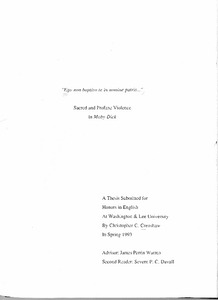| dc.rights.license | In Copyright | en_US |
| dc.creator | Crenshaw, Christopher Carson | |
| dc.date.accessioned | 2023-10-20T15:49:41Z | |
| dc.date.available | 2023-10-20T15:49:41Z | |
| dc.date.created | 1993 | |
| dc.identifier | WLURG038_Crenshaw_thesis_1993 | |
| dc.identifier.uri | https://dspace.wlu.edu/handle/11021/36295 | |
| dc.description.abstract | Moby-Dick presents intriguing patterns of violence that I believe to be in need of further exploration. . . . The publication of Sir James Frazer's The Colden Bough in 1890 produced a new form of cultural anthropology with a set of assumptions and judgments that remained largely unquestioned until 1972. when Rene Girard published Violence and the Sacred. Girard's book targets specifically Frazer's notion that ritual proceeds from myth; he wishes to invert this causal link and show that myth, in fact, proceeds from ritual. Girard deals primarily in cultural patterns of violence which we may divide into the categories of sacrecl and prqfcme. What I term profane violence is violence that is reciprocal: the violence of the feud, for example, in which clans strike retaliatory blows against one another in an ever
escalating cycle. Because this violence threatens to escalate until it destroys the entire community, it must be checked. The check to profane violence is sacred violence in the form of the ritual sacrifice. The community, in order to break the reciprocal cycle of violence, unanimously concentrates its cumulative guilt and desire for revenge onto a surrogate victim, which bears the brunt of the society's
violence. It is in this unanimous act of sacred violence that myth is born. Girard's description of a dual sacred and profane nature uf violence seems particularly relevant to the patterned violence of Ahab's vengeful quest to destroy Moby Dick. Girard's attention to the rite also applies to Ahab's repeated corruption of religious rituals. This thesis will provide a re:tding in four parts of Moby-Dick based in Girard's analyses of sacred and profane violence and of the rite of sacrifice. The first part will examine Father Mapple's sermon on Jonah as evidence of the allegorizing imagination which reads physical objects as spiritual symbols, and examine Girarcl's own exploration of Jon;th. It will then show how Ahab both shares and corrupts this characteristic. The second p;1rt will provide a close reading of Ahab's 4uest as a corruption of the rite of sacrifice. The third part will contrast the figures of Ahab and Ishmael in terms of the allegorizing imagination. The fourth and final part of the thesis will provide an explicit
reading of "The Chase" against Ishmael's "Epilogue" as offering opposing alternatives of violence and peace, and conclude by showing how Ishmael offers his own form of redemption from the cycle of reciprocal violence. [From Introduction] | en_US |
| dc.format.extent | 67 pages | en_US |
| dc.language.iso | en_US | en_US |
| dc.rights | This material is made available for use in research, teaching, and private study, pursuant to U.S. Copyright law. The user assumes full responsibility for any use of the materials, including but not limited to, infringement of copyright and publication rights of reproduced materials. Any materials used should be fully credited with the source. | en_US |
| dc.rights.uri | http://rightsstatements.org/vocab/InC/1.0/ | en_US |
| dc.title | "Ego non baptizo te in nomine patris...": Sacred and Profane Violence in Moby-Dick | en_US |
| dc.type | Text | en_US |
| dcterms.isPartOf | WLURG038 - Student Papers | en_US |
| dc.rights.holder | Crenshaw, Christopher Carson | en_US |
| dc.subject.fast | Moby Dick (Melville, Herman) | en_US |
| dc.subject.fast | Violence | en_US |
| dc.subject.fast | Rites and ceremonies | en_US |
